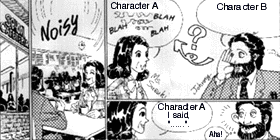|
|
|
Pragmatics and American Conversational Usage with Samuel Schenker |
|
|
|
Pragmatics and American Conversational Usage with Samuel Schenker |
If the pragmatics of a conversational exchange involves communicating
more than is apparent in the words, learners would need to be
provided with as complete a picture of the conversational situation
as possible; otherwise, it would be difficult for them to understand
how language is used in terms of appropriateness.
Now, with a new, ingenious pic-word format it is possible to facilitate
a better understanding of conversational usage, in this case,
American. Through playing simulated, multi-level usage games,
learners are also able to prepare themselves for real-life communication.
Here, then, is an outline of this approach and some of the reasons
why it is effective.
1. The pic-word format makes the components and substance
of each situation clear!
|
Game 1 |
||
| Conversational Focus The cafeteria is so noisy that Johnny cannot hear what Ms. Suzuki is saying, and so ... カフェテリアはそうぞうしかった。ジョニーはスズキ先生の言葉が聞き取れない。 |
Communication Function CharacterB Asking someone to repeat something もう一度言ってくれるよう頼む |
Character B 1. Pardon (me)? |
 What would you say? |
||
Anyone who has used a textbook to teach English for any length of time is probably aware that learners also make mistakes for no other reason than because all the elements of a conversational situation are not clear. For example, the relationship between the speakers may be vague or ambiguous, making it difficult for learners to discover how to use language appropriately.
I, John Pereira, began exploring different ways to make the elements clearer. I discovered that the most effective initial way to represent the real world was to use unambiguous visual information. As a result, I developed Stimu-Con Usage Games which utilize what I call a "pic-word" format that allows the elements of situation, communication function, character roles, relationships, facial expressions, and gestures to form a coherent setting. In addition, time, space, and action can all be communicated as in videos, even though there is no movement at all.
My classroom experience with these materials confirmed my observations: there were very few misunderstandings about what was taking place in each setting, and everyone said they loved the use of comics, which kept the interest level high.
|
|
|
|
|
|
|